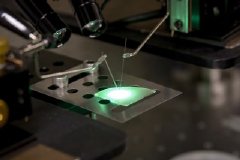Sep 4 2009
Just a few years ago, most conversations Christian Wetzel from Rensselaer Polytechnic Institute had about his research began with a quick explanation of LEDs.
 Rensselaer Professor Christian Wetzel is working to create better, brighter green LEDs that could lead to a new generation of high-performance, energy-efficient monitors, TVs, and other display and lighting devices.
Rensselaer Professor Christian Wetzel is working to create better, brighter green LEDs that could lead to a new generation of high-performance, energy-efficient monitors, TVs, and other display and lighting devices.
More recently, however, he's noticed that the mention of LEDs - light-emitting diodes - no longer prompts puzzled looks. He rarely has to delve into the elevator pitch about LEDs needing only a fraction of the energy required by conventional light bulbs, or mention that LEDs contain none of the toxic heavy metals used in the newer compact fluorescent light bulbs. He no longer has to sell the idea that LEDs are incredibly durable and long-lived.
The virtues of sustainability and efficiency are now so engrained in the public consciousness, Wetzel said, that he can usually skip over the nuts and bolts of solid-state lighting and instead launch right into his work on developing a high-performance, low-cost green LED.
"Going green means different things to different people. For most, it means being more conscious about the environmental and global impacts of one's actions. For companies, going green also means making a profit by selling equipment and services that allow one's customers to be more efficient and reduce costs," said Wetzel, professor of physics and the Wellfleet Professor of Future Chips at Rensselaer. "I'm doing both of those, but I'm also trying to make an LED that literally shines green light."
First discovered in the 1920s, LEDs are semiconductors that convert electricity into light. When switched on, swarms of electrons pass through the semiconductor material and fall from an area with surplus electrons into an area with a shortage of electrons. As they fall, the electrons jump to a lower orbital and release small amounts of energy. This energy is realized as photons - the most basic unit of light. Unlike conventional light bulbs, LEDs produce almost no heat.
The color of light produced by LEDs depends on the type of semiconductor material it contains. The advancement of LED technology, Wetzel said, has followed a specific progression. The very first LEDs were red, and not long thereafter researchers tweaked their formula and developed some that produced orange light. Next in line, after considerable research efforts and some key breakthroughs, were blue LEDs, which can easily be found today as blue light sources in mobile phones, CD players, laptop computers, and other electronic devices.
The holy grail of solid-state lighting, however, is a true white LED. Wetzel said the white LEDs commonly used in novelty lighting applications, such as key chains, auto headlights, and grocery freezers, are actually blue LEDs coated with yellow phosphorus - which adds a step to the manufacturing process and also results in a faux-white illumination with a noticeable bluish tint.
The key to true white LEDs, Wetzel said, is all about green.
"We have high-performance red LEDs, we have high-performance blue LEDs, and if we paired them with a high-performance green LED we would be able to produce every color visible to the human eye - including true white," he said. "Every computer monitor and television produces its picture by using red, blue, and green. That means developing a high-performance green LED would likely lead to a new generation of high-performance, energy-efficient display devices. The problem, however, is that green LEDs are much more difficult to create than I, or anyone else, imagined."
Simple preliminary attempts to create green LEDs, by merely adding more indium (In) to the gallium nitride (GaN) materials that composed blue LEDs, were unsuccessful. The resulting green LEDs just weren't strong or bright enough to stand toe-to-toe with red or blue. Wetzel and his research group have been working to tweak precisely how to add more indium, and how to grow the structure more carefully into a device, with the goal of boosting the strength and light output of green LEDs. They're endeavoring, he said, to "close the green gap."
Once they overcome the challenge of developing efficient green LEDs, he envisions LED technology will quickly evolve from its current applications in signs and small displays and grow into a universally adopted, globally used replacement for traditional light bulbs and compact fluorescence tubes. Wetzel said lights for general lighting applications, as well as the lighting of televisions, computer screens, and other electronics devices, will be cheaper, more energy efficient, and more reliable if we used LEDs.
"This is a new and exciting technology that holds immense promise, but the technological landscape is constantly in flux and we still have a ways to go before we are able to fully realize the energy and cost savings of LEDs," Wetzel said. "But I know that people are interested in lighting their homes and powering their devices with LEDs because they're always asking me, 'so when can I buy one?'"
Wetzel has been working on this problem for several years, and in recent months received an additional $1.8 million in funding from the U.S. Department of Energy. He has also partnered with several companies, large and small, to join efforts and finally close the "green gap" once and for all.